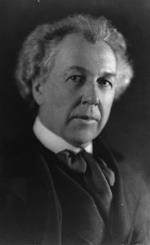Frank Lloyd Wright and Le Corbusier instinctively knew how to get in the spotlight - even if it was more egos than axos, says Gillian Darley

The top seven floors of Frank Lloyd Wright’s putative Mile-High Illinois for Chicago, a 528-storey tower presented by the near-90-year-old architect to an astonished public in 1956, were to have been television studios.

In this supreme embodiment of architectural machismo, the elevation of the media to the pinnacle of Wright’s hubristic design says everything about the first generation of starchitects’ penchant for the limelight. Early adapters in the race for column inches or airtime, they affected memorable touches in dress (FLW and his big hats, floppy foulards and tweed of the highest quality; Corb’s owl glasses, double-breasted suits and toned physique) and never shied away when the opportunity offered to saunter, nonchantly, into shot.
The current exhibition at MoMA, drawing on the immense archive from the Frank Lloyd Wright Foundation now lodged permanently in New York, includes numerous film clips and shows how expertly FLW handled and exploited television in the early days. In 1956 he wangled a seat on What’s my Line and in 1957 talked at length to Mike Wallace, the doyen of TV interviewers.
The fame of international architects brought them into the British living room too. The British Film Institute is marking the London Festival of Architecture with a selection of archive television programmes, and kicked off with two BBC films about Le Corbusier who, despite his visit to the Architectural Association, his 1953 RIBA Gold Medal and continual, exhaustive, coverage by the professional press, built nothing in this country. The short 1959 film (in the Monitor arts series) is in black and white and magisterial in tone and accent (a bit like my university lectures a decade later), presenting an utterly mainstream view of Corb, with a brief insert in which the 71-year-old hero introduces himself as painter, sculptor but, oddly, not as architect.
In 1972, the BBC had another go, after Corb’s death. This was a 50-minute Omnibus film, in colour. It has never been seen since. The tone of the script here is questioning and thoughtful and when the final titles roll they reveal the writer to be Charles Jencks, whose book, Le Corbusier and the Tragic View of Architecture was published the following year. The footage in and around buildings, Villa Savoie, Ronchamp and La Tourette particularly, and the expansive coverage of, and discussion around, Chandigarh marked a sea change in the way architecture was filmed. The producers were, perhaps, throwing down the gauntlet to the long-term cultural tsar at the BBC, Huw Wheldon, and the man behind Monitor who famously and repeatedly said architecture did not work on television.
It was, however, the democratisation of the medium that put architecture and design forward on the home screen – aided perhaps by the continual and contentious interventions of Prince Charles, on air as well as in print. One of the most persuasive television vehicles of all was Building Sights which ran for four series, starting in 1988 and ending in 1996, offering 10-minute snapshots of individuals (myself included) talking about inspiring or favourite buildings (mine was the David Mellor Factory in Derbyshire, by Hopkins Associates). Norman Foster subverted things by looking at the Boeing 747 while Richard Rogers stayed grounded with the Alton Estate.
With that, the BBC brought architecture, engineering and design into sharp focus, measuring success by the resolution of the brief, and the wider satisfaction gained, rather than merely acting as a mirror for architectural vanity.
















5 Readers' comments